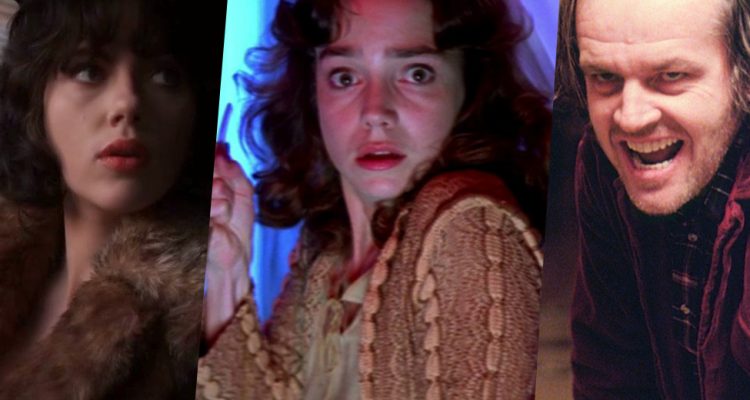 “The Shining” (1980)
“The Shining” (1980)
Oscar-winning DP John Alcott built up a solid working relationship with legendary perfectionist Stanley Kubrick, having shot “2001, “Clockwork Orange” and “Barry Lyndon” prior to this, their last collaboration. This experience helped Alcott turn the labyrinthine, illogically-designed Overlook Hotel, with its chilling hedge maze and red-soaked bathrooms, into an iconic location for past and present supernatural terror. He got a lot of help from Garrett Brown’s Steadicam, which while it first appeared in “Halloween,” became a thing of legend in “The Shining.” It follows Danny (Danny Lloyd) on his tricycle around the hotel’s colossal hallways and Native-American symbology, only to stop him (and our hearts) with the sudden shot of former caretaker’s Charles Grady’s twin daughters. Or how about the scene when Danny is running from his murderous father (Jack Nicholson) in the maze? The blood slowly gushing out of the elevators, Jack swinging that baseball bat at poor Wendy (Shelley Duvall); the list of tremendously composed shots is never-ending. From the opening careening birds-eye-view shot of the Torrence family traveling to the hotel, to the slow zoom of the unsettling photograph, Alcott’s iconic visuals match the grandeur of Kubrick’s genius for cinematic storytelling at every turn.
 “Psycho” (1960)
“Psycho” (1960)
Anthony Perkins’ creepy smile. Janet Leigh’s shocking death in the shower. Bernard Hermann’s piercing score. Alfred Hitchcock’s genius for turning the audience into active participants. These are just a few of the reasons why “Psycho” is the most classic of all horrors on this list. It marked a new dawn for the horror picture, transgressing every convention to such a degree that all subsequent discussions about the genre were classified into pre- and post-“Psycho” periods. But rarely is the film’s look talked about. Jack Russell’s cinematography, like all past and future DPs who worked with Hitchcock, is naturally overshadowed by the director’s infamous auteurist aura, but the film’s black-and-white, low-budget aesthetic plays an essential role in submerging us under Hitchcock’s spellbinding exploitative tale. Who can forget the ominous shot of Bates manor perched up on that hill, late at night? Half the reason why the shower scene is one of the greatest ever committed to celluloid is the lighting effects through the curtains and of the shadowy figure of Mother. And what about that fateful moment Leigh’s Marion sees that Bates Motel is vacant through the torrential rain? “Psycho” is the redefining gamechanger in every respect, including its meticulous use of image to convey mood.
 “Kwaidan” (1964)
“Kwaidan” (1964)
Japanese ghost horrors are a special breed unto themselves; when they’re rendered with beautiful imagery and camerawork, they become like cryogenically frozen myths with the uncanny ability to haunt generations to come. Masaki Kobayashi’s anthology of four creepy folktales might just be the most handsome of the lot. “Kwaidan” is a testament to the visual power of painteresque set designs (decorated by Dai Arakawa, with art designed by Shigemasa Toda) that burst with storytelling purpose and lavish colors, all gracefully captured with the award-winning camerawork of Yoshio Miyajima. The film is sprinkled with supernatural elements that, if they are not scary on the surface, reverberate in melancholic, sad, and unsettling tones throughout, and the characters and stories that populate “Kwaidan” tackle themes of guilt, oppressive marriages, samurai culture and spirit-worlds in snowy forests, under blood-red skies and in mist-covered interiors. Kobayashi hit his stride with stark black-and-white dramas like “The Human Condition” and “Harakiri” and made not one but four of the most impressive and gorgeously classical ghost stories from the 60s (Kaneto Shindo’s “Kuroneko” from the same decade is a close competitor). Thanks to his crew behind the scenes, he reminded us what a visual spectacle horror can be.
 “Repulsion” (1965)
“Repulsion” (1965)
Roman Polanski’s first English-language film and the first in his famed Apartment Trilogy is a masterful example of tension-building and internalized psycho-sexual paranoia. It’s in this second aspect that “Repulsion” excels through two principal players; Catherine Deneuve, who takes on the challenging role of the mentally fragile Carol with incredible agility, and Gilbert Taylor, the cinematographer who shot “Dr. Strangelove” a year earlier and would go on to handle “Star Wars” and “The Omen” in the 1970s. Taylor’s lighting and camera movements around Carol’s increasingly frightening apartment, coupled with Polanski’s singular relationship with claustrophobic intimacy, yields some of the most unforgettable visuals in the sub-genre of psychological horror. Surreal visions of hands coming out of walls, contorted reflections in teapots and destabilizing angles tilted up from floor-level all serve to entrap us in Carol’s disturbing psyche. Taylor’s cracking black and white photography resulted in a BAFTA nomination and two more collaborations with Polanski (“Cul-de-Sac” and “The Tragedy of Macbeth”).
 “Don’t Look Now” (1973)
“Don’t Look Now” (1973)
The decadent surroundings of a wintry Venice imbue Nicholas Roeg’s masterwork with an atmosphere that coils around our wrists and throat, never letting us forget “Don’t Look Now.” Fiercely edited by Graeme Clifford and organically shot by Anthony Richmond (for which he won a BAFTA), the story of how a grief-stricken husband and wife deal with the death of their young daughter is absolutely haunting, from the opening sequence of the child drowning all the way to the final climax and one of the most spine-chilling reveals in the history of the genre. Donald Sutherland and Julie Christie are in searing form as the psychologically broken couple, but the film’s mercurial nature owes more to the collaboration between Richmond and Roeg behind the camera. With natural lighting, Richmond turns the murky underworld of wet Venice into a labyrinthine mind-maze; ghastly reflections, sudden camera movements, dark passages presaging darker omens, vertiginous angles and a mist that seems to grow thicker as the film nears its harrowing conclusion. The imagery in ‘Don’t Look Now’ illuminates the psychological state of grief and all its horrifying chambers, and has influenced countless of contemporary filmmakers —from Steven Soderbergh to Ben Wheatley.

